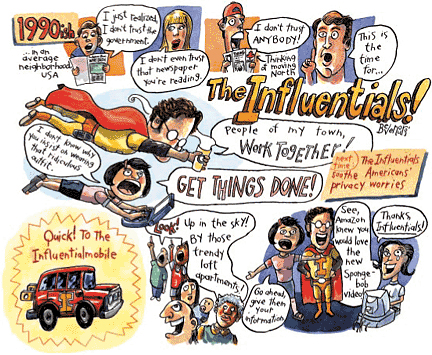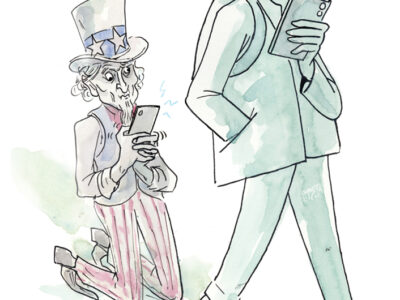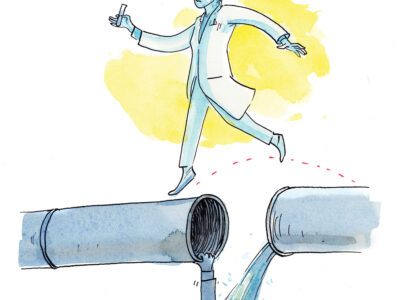
Where the “Influentials” go, the rest of us follow.
By Ed Kelle
They aren’t the first names that might come to mind when you think about the people with influence—government leaders, corporate CEOs, the wealthy—but for the last half-century they’ve shaped the opinions and trends in our country—and now more than ever.
Dubbed by my firm, RoperASW, “the Influential Americans®,” they make up roughly one-tenth of the U.S. adult population. The most socially and politically active Americans—selected from the general population on the basis of their involvement in local affairs—they are at the leading edge of what Americans are thinking, doing, and buying. If we want to gauge the prospects for a new product, service, legislative initiative, or idea, we look at how it is regarded by Influentials. They point the way to the future.
The concept of the Influentials dates back to the 1940s, but in the 1990s Influentials became a major area of interest to us as we began to note a dramatic increase in self-reliance on the part of the American people: People were taking individual responsibility for solutions to problems. There had been a declining trust in large institutions, a declining trust in the news media, and a declining trust in the government. Instead, people told us they were relying more on friends, family, and neighbors to get things done. The role of the Influentials would become even more important as a result.
Today’s Influentials might have started local education foundations to help their schools or be involved in land preservation. Whatever the local issues, these are the people who—when the rest of us go home tired at the end of the day and want to spend time with our families—somehow have the energy and inclination to go to that meeting on a Monday night.
Because they know and interact regularly with so many people, Influentials hear about things well ahead of the mainstream; hear more points of view, giving them sounder perspectives; and have a broader network to get the word out when they have a concern or have found something they really like. In turn, they have a disproportionate impact.
Of all the changes in America that we have tracked over the past three decades, one of the most far-reaching is the growing power of word-of-mouth. Americans place one-and-a-half times more value on the word-of-mouth of friends, family, and other people for insights and ideas on decisions than they did in the 1970s. As a result, word-of-mouth is now valued twice as much as the editorial product and advertising of the traditional media. The Influentials —because of their wide personal network, their deep reserves of insight, and the respect they command—are generally at the center of the conversation. Influentials are twice as likely as the average American to be asked their advice or opinion, and twice as likely to make a recommendation when they find something they like.
You don’t have to be a celebrity to be an Influential. They’re in every community in the country. Men and women are equally likely to be Influentials. They tend to be somewhat above average in wealth, but their money doesn’t gives them influence. Rather, it’s a belief that individuals can make a difference. They are not satisfied with the status quo.
Influentials were very much ahead of the game in adoption of PCs (in 1986 almost one in three Influentials had a PC, more than double the total public; today more than eight in 10 have a computer, compared to about half the total public), as well as in the Internet, cell phones, digital cameras, and online shopping. They led the move to smaller, more fuel-efficient cars in the 1970s and today are very interested in hybrid cars for fuel-efficiency and environmental benefits.
Using the Influentials as a guide, here are some future trends to watch for:
- Global Connections. With the current world tensions, many pundits have been wondering whether Americans want to withdraw from the rest of the world. From what Influentials tell us, we don’t see it. Rather, we think there will be continued globalization of Americans’ lifestyles, bringing more tastes and ideas into life here, from cuisine to music, design, fashion, furniture, leisure pursuits, and beliefs. Influentials have a passionate interest in the world; almost eight in 10 say other countries and peoples are a personal interest of theirs. Foreign travel is one of their favorite experiences. Sourcing stories from other countries is commonplace among Influentials; a recent Roper survey shows 65 percent of Influentials have looked at media sources from outside the U.S. (among the rest of the public, the figure is 39 percent). With the Internet putting the world literally at people’s fingertips, there is going to be a growing expectation—first among Influentials, but soon enough all consumers—that companies connect them to products and services they want, anywhere in the world.
- PC-Centered World. It’s become conventional wisdom that with the dotcom stock bust, the Internet era is over. Nothing could be further from the truth. Influ-entials have quietly continued to expand their use of the Internet. With high-speed Internet access beginning to reach critical mass—more than one in three Influentials now have broadband access —we expect to see a whole raft of online activities get a new head of steam. The result is setting the stage for what we think will be a new phase of technological innovation. Rather than fading into the background, the personal computer is becoming a central nervous system for the home—archiving everything from medical records, music, and video collections to family photo albums and financial records, and linking them to entertainment and productivity stations around the house. Many Influentials foresee new generations of time- and labor-saving devices in the next two decades, from medical smart cards that enable doctors with a swipe of the card to learn your health history and insurance information to portable language-translation software and household robotics.
- Living Longer Stronger. There’s a lot of talk today about the aging of the population. But, based on what we hear from Influentials, we think the more interesting discussion is going to be how America ages. Though you don’t often see it on the front page of the newspaper, a quiet transformation has already begun. The year 2001 saw records eclipsed for oldest person to climb Mount Everest (64), a new world record marathon time for the 70-74 age group (three hours), and the oldest person to write a bestseller (92). Influentials have high expectations of what old age can bring. The images they associate with it—“time to enjoy yourself,” “wisdom,” “being a role model for young people,” “having time to help others,” “closer ties to family”—suggest they are going to approach the next phase of life with vigor and a sense of adventure. “Looking your age” is losing its meaning. If you can run a three-hour marathon at 70, you’re not the traditional image of aging. Influentials are open to doing things to look younger—particularly exercise—but also anti-aging cosmetics and coloring your hair. The old ad line “does she or doesn’t she?” has become “why not?” Most Influentials are counting on medical innovations from portable health monitors to surgical breakthroughs to open up even more boundaries and enable people to be more self-reliant as they age.
All of these trends—and others that we are tracking as well—are going to create a bevy of opportunities for marketers and policy makers—if they can keep up. And, as with the past innovations that Influentials have led, we think the public will be happy to follow.
Ed Keller C’77 ASC’79 is CEO of the global marketing-research and consulting firm RoperASW and author, with Jon Berry, of The Influentials (Free Press, 2003).




